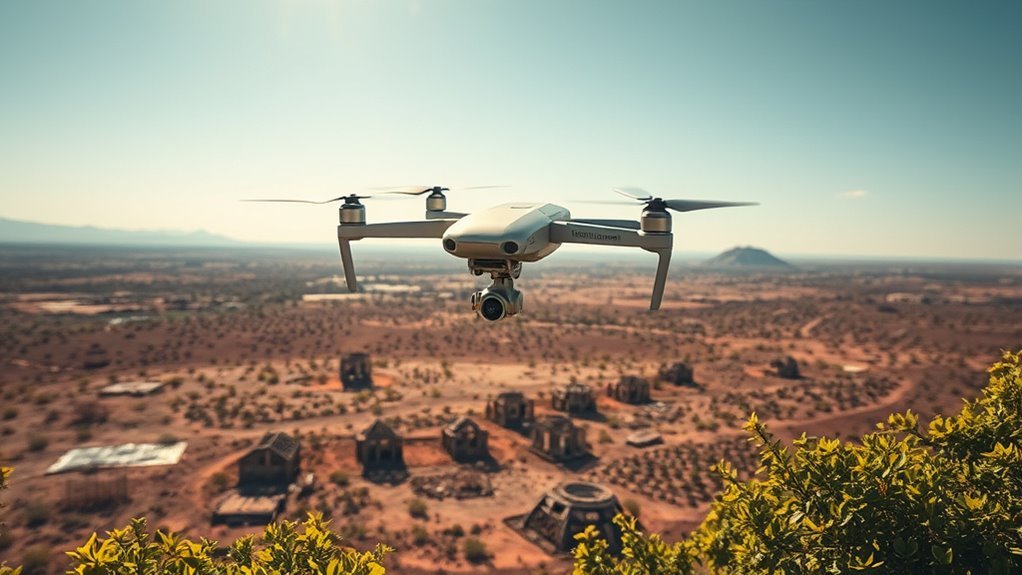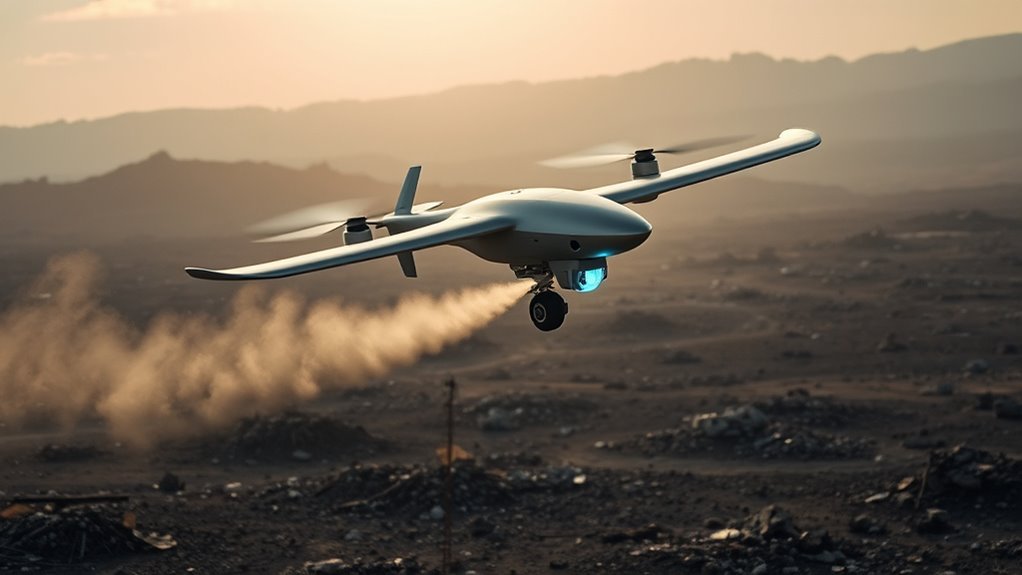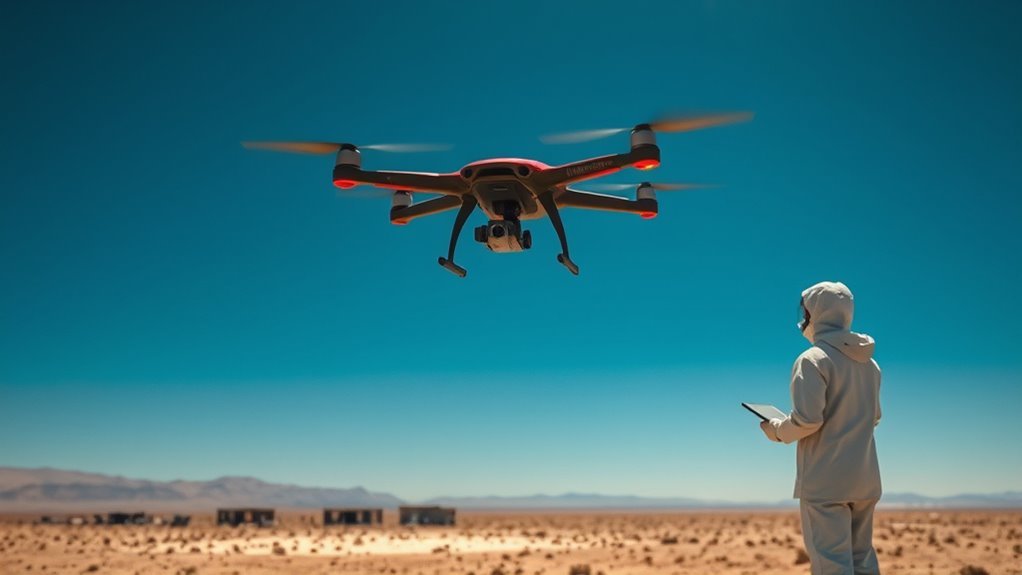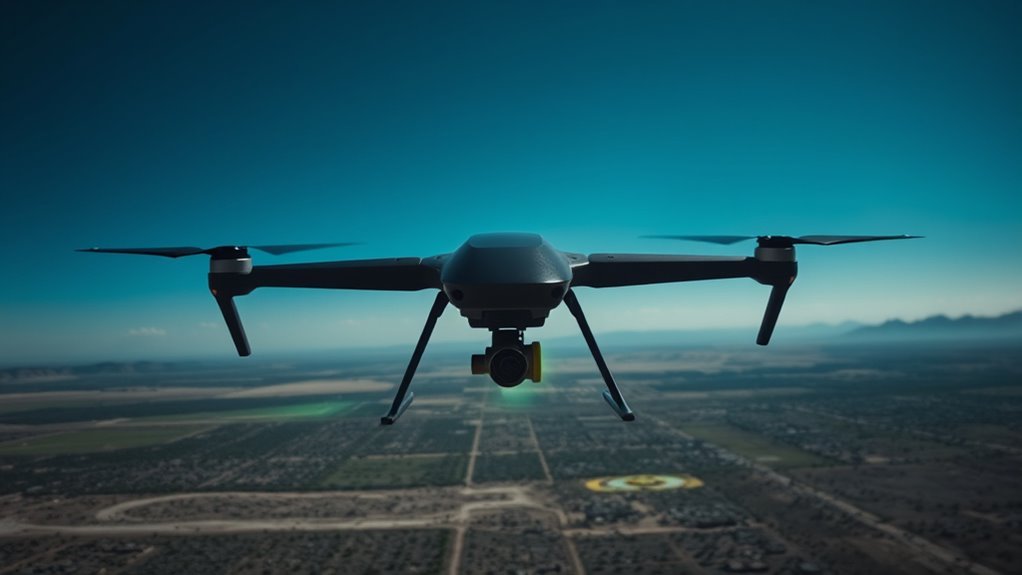Drones play an essential role in radiation detection by utilizing advanced sensor technology for accurate monitoring. They can access hard-to-reach areas, providing real-time data collection that aids in evaluating radiation levels during emergencies or monitoring nuclear facilities. Different sensors like Geiger-Müller counters and gamma ray spectrometers enhance detection capabilities, ensuring efficient and safe operations. As new technologies emerge, the potential for improved accuracy and decision-making expands. Discover more about the future advancements in this field.
The Importance of Radiation Detection

Radiation detection plays an essential role in ensuring safety across various fields, including healthcare, environmental monitoring, and nuclear facilities. You need to understand that identifying radiation sources accurately is vital for minimizing risks to public health and the environment. High detection accuracy allows for timely interventions, preventing the spread of contamination and protecting individuals from potential harm. Furthermore, advancements in detection technology have improved the precision of measurements, enabling better assessments of radiation levels in various settings. By prioritizing effective radiation detection, you not only enhance safety protocols but also empower communities to take informed actions regarding their exposure. This commitment to accuracy and vigilance fosters a more secure environment, aligning with your desire for freedom from harmful radiation exposure.
How Drones Are Equipped for Radiation Monitoring

To effectively monitor radiation, drones integrate advanced sensor technology that detects various radiation types with high accuracy. You’ll find that optimizing flight paths is essential for maximizing data collection efficiency and coverage. This combination enhances the drones’ ability to provide real-time assessments in radiation-sensitive areas.
Sensor Technology Integration
Drones have emerged as essential tools in the domain of radiation monitoring, thanks to their advanced sensor technology integration. By incorporating sophisticated radiation sensors, drones can detect various types of radiation, offering real-time data that’s vital for safety assessments. This data collection hinges on precise sensor calibration, ensuring that measurements are accurate and reliable. In addition, effective data integration allows you to analyze results against established benchmarks, enhancing situational awareness during monitoring missions. With the ability to cover large areas quickly, these drones empower you to respond to radiation threats more efficiently. The ongoing advancements in sensor technology continue to broaden the potential applications of drones in this critical field, promoting a proactive approach to radiation safety.
Flight Path Optimization
Enhancing flight paths greatly improves drones’ effectiveness in radiation monitoring. Through flight path analysis, you can guarantee that drones navigate efficiently over potential radiation hotspots, minimizing time spent and maximizing data collection. Advanced algorithms facilitate aerial navigation, allowing drones to adapt in real-time to environmental changes and obstacles. By employing geospatial data, you can define ideal routes that cover larger areas with precision. This not only improves the quality of radiation measurements but also increases the likelihood of detecting anomalies. Additionally, integrating machine learning can refine these paths based on previous missions, enhancing future performance. Ultimately, efficient flight path enhancement empowers you to monitor radiation levels more effectively, guaranteeing safety and informed decision-making in critical situations.
Types of Sensors Used in Drone Radiation Detection

When it comes to detecting radiation with drones, you’ll find several key sensor types in use. Geiger-Müller counters, scintillation detectors, and gamma ray spectrometers each offer distinct advantages for radiation measurement. Understanding their functionalities can enhance your insights into effective radiation monitoring strategies in various environments.
Geiger-Müller Counters
The effectiveness of radiation detection in drone applications heavily relies on the sensors employed, with Geiger-Müller counters being among the most prominent. These Geiger counters are essential for ensuring radiation safety, as they detect ionizing radiation through the ionization of gas within a tube.
Here’s a quick overview of their features and benefits:
| Feature | Advantages | Limitations |
|---|---|---|
| Detection Range | Wide range of radiation | Limited energy resolution |
| Response Time | Fast response | May miss low-energy events |
| Portability | Lightweight and compact | Requires calibration |
| Cost | Relatively affordable | Sensitive to environmental factors |
| Ease of Use | User-friendly interface | Needs regular maintenance |
Utilizing these counters enhances your drones’ capabilities in monitoring hazardous areas effectively.
Scintillation Detectors
Scintillation detectors play an essential role in enhancing radiation detection capabilities for drones. These devices utilize scintillation materials, which emit light when exposed to ionizing radiation, allowing for quick and accurate detection. When you deploy drones equipped with these detectors, you’re benefiting from their sensitivity across various radiation types, making them invaluable for environmental monitoring or emergency response scenarios. However, effective use depends on proper detector calibration; without it, the readings can be misleading. Regular calibration guarantees that the scintillation detectors maintain their accuracy, providing reliable data during operations. By integrating scintillation detectors into drone systems, you’re not just enhancing detection efficiency—you’re also promoting safety and informed decision-making in potentially hazardous environments.
Gamma Ray Spectrometers
Incorporating gamma ray spectrometers into drone systems greatly enhances radiation detection capabilities. These advanced sensors allow for precise identification and quantification of gamma radiation, essential for various gamma ray applications, such as environmental monitoring and nuclear safety. By utilizing gamma ray spectrometers, you can considerably improve drone efficiency, enabling quicker assessments of contaminated areas. The spectrometers analyze energy levels of emitted gamma rays, helping to distinguish between different isotopes. This capability not only aids in the detection of radioactive materials but also informs necessary safety measures. As you explore the integration of these sensors, consider how they elevate the overall effectiveness of drone operations in radiation detection, ensuring a safer environment for all.
Applications of Drones in Disaster Response
As communities face the aftermath of disasters, drones are proving to be invaluable tools for response efforts. Their ability to quickly assess damage and gather real-time data enhances disaster recovery coordination. Utilizing effective drone deployment strategies, responders can cover extensive areas that might be hazardous for personnel. For instance, in the wake of floods or earthquakes, drones can map affected regions, identify survivors, and deliver essential supplies. In addition, drones equipped with thermal imaging can locate heat signatures, aiding in search and rescue operations. By integrating drone technology into response plans, communities can streamline efforts, ensuring resources are allocated efficiently. This innovative approach not only saves time but also empowers communities to reclaim their autonomy in disaster recovery scenarios.
Monitoring Nuclear Facilities With Drones
The use of drones is expanding beyond disaster response to critical areas like monitoring nuclear facilities. By employing drone surveillance, you can enhance nuclear safety measures and guarantee compliance with regulations. Drones can access hard-to-reach areas, capturing real-time data on radiation levels, structural integrity, and environmental conditions. Here’s a breakdown of their roles:
| Function | Benefits | Applications |
|---|---|---|
| Radiation Detection | Immediate feedback | Regular inspections |
| Structural Monitoring | Identify vulnerabilities | Emergency preparedness |
| Environmental Analysis | Assess ecosystem impact | Regulatory compliance |
Incorporating drones into nuclear facility oversight not only streamlines operations but also increases safety and transparency, aligning with a collective desire for freedom from potential hazards.
Environmental Assessments and Drones
While traditional methods of environmental assessment can be time-consuming and limited in scope, drones offer a transformative approach to gathering critical data. Their advanced drone capabilities enable high-resolution aerial surveys, allowing you to monitor large areas quickly and efficiently. This is particularly advantageous for environmental monitoring, as drones can access remote or hazardous locations without putting personnel at risk. Equipped with specialized sensors, they can detect radiation levels, assess soil contamination, and evaluate ecosystem health with precision. By integrating drone technology into your environmental assessments, you can enhance the accuracy of your findings while reducing the time and resources typically required. Embracing this innovative solution not only streamlines the assessment process but also empowers you to make informed decisions for environmental protection. Additionally, the real-time data analytics provided by drones can further improve decision-making during assessments.
Benefits of Using Drones for Radiation Detection
Integrating drones into radiation detection processes greatly enhances data collection efficiency and accuracy. By leveraging this technology, you can experience significant drones benefits that traditional methods often can’t match. Here are four key advantages:
Integrating drones into radiation detection significantly boosts efficiency and accuracy, offering unique advantages over traditional methods.
- Access to Hard-to-Reach Areas: Drones can easily navigate challenging terrains, ensuring thorough coverage.
- Real-Time Data Collection: They provide immediate feedback, enabling quicker decision-making during radiation assessments.
- Cost-Effectiveness: Drones reduce the need for extensive manpower and expensive equipment, making radiation detection more economical.
- Enhanced Safety: Using drones minimizes human exposure to hazardous environments, protecting operators while ensuring effective monitoring.
Future Trends in Drone Technology for Radiation Monitoring
As advancements in drone technology continue to accelerate, you’re likely to see innovative applications for radiation monitoring that enhance both efficiency and accuracy. Future innovations may include the integration of AI algorithms, allowing drones to analyze radiation data in real-time, making decision-making processes faster and more informed. Additionally, improved sensor technology will increase detection capabilities while reducing false positives. However, these developments must navigate evolving drone regulations, which may dictate operational parameters and safety protocols. As you explore these trends, consider how a balance between technological advancement and regulation can empower individuals and organizations to monitor radiation more effectively, ultimately fostering a safer environment for communities and promoting transparency in public health.
Frequently Asked Questions
How Do Drones Communicate Radiation Data to Operators?
You might wonder how drones relay vital radiation data. Through precise sensor calibration and reliable data transmission, they send real-time information back to operators, ensuring rapid response and informed decisions in critical situations.
What Is the Range of Drone Radiation Sensors?
The range of drone radiation sensors varies considerably based on drone specifications and sensor accuracy. Generally, they can detect radiation over distances from a few hundred meters to several kilometers, depending on environmental conditions and equipment capability.
Are Drones Capable of Detecting All Types of Radiation?
While drones can detect many radiation types, they’re not foolproof. For instance, they often struggle with low-level gamma radiation, revealing significant detection limitations. Understanding these constraints is essential for effective monitoring and ensuring safety in diverse environments.
Can Drones Be Used in Urban Areas for Radiation Detection?
Yes, drones can effectively navigate urban environments to identify radiation hotspots. Their agility and advanced sensors allow for precise detection, making them invaluable tools in monitoring and ensuring safety in densely populated areas.
How Do Weather Conditions Affect Drone Radiation Monitoring?
Weather conditions greatly impact drone performance, affecting stability and sensor accuracy. Wind, rain, and temperature variations can hinder data collection efficiency, potentially leading to inaccurate radiation readings. Understanding these factors is essential for effective monitoring operations.

